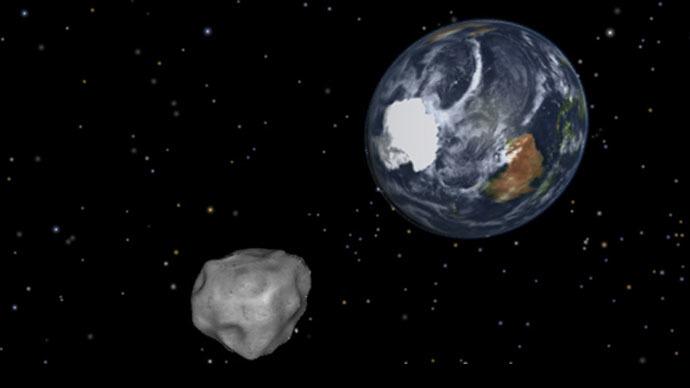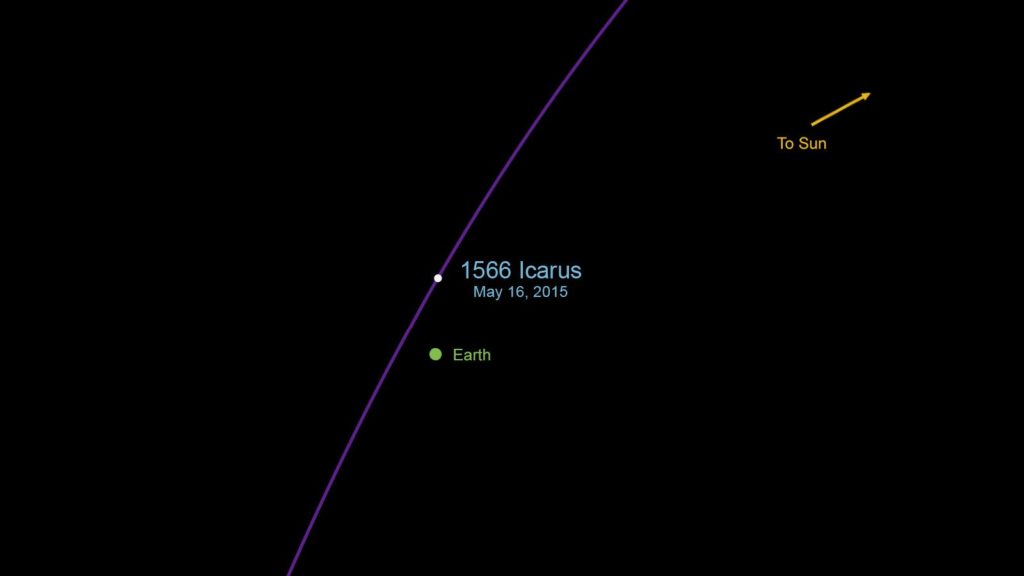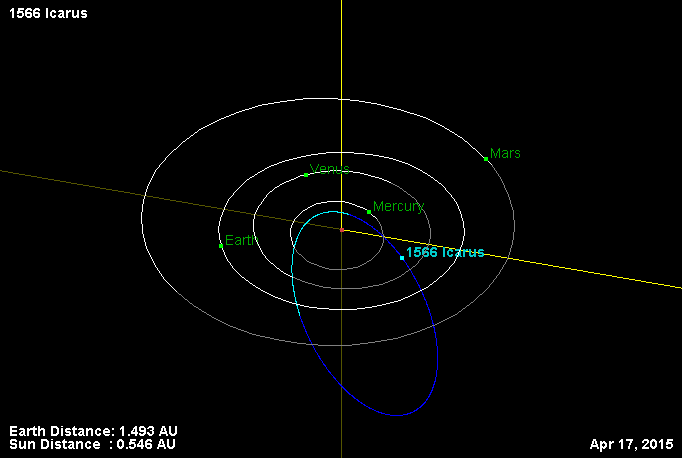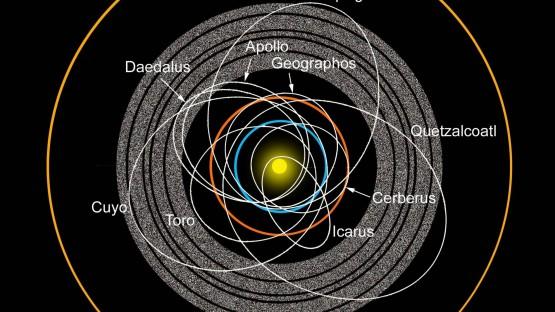1566 Icarus, is an asteroid with an extremely eccentric orbit, the first to be observed by radar being a near-Earth object of the Apollo group.
Key Facts & Summary
- 1566 Icarus is one of the lowest numbered potentially hazardous asteroids having 0.87 mi / 1.4 km in diameter.
- The asteroid's orbit takes it even closer to the Sun than the planet Mercury.
- On the other end, its orbits takes it as farther away than the orbit of Mars, making the object a Mercury, Venus, and Mars-crosser.
- 1566 Icarus was discovered in 1949 by the German astronomer Walter Baade. It later became the first asteroid ever observed by radar in 1968.
- Though the origins of meteor showers are often tough to pinpoint, 1566 Icarus is believed to be responsible for the Arietids meteor shower, which typically occurs during the daytime.
- 1566 Icarus comes very close to Earth, even though it poses no threat the celestial object can be only 0.0352 AU away.
- The asteroid orbits the Sun at a distance of 0.2 and 2.0 AU once every 409 days.
- Icarus has an eccentric orbit of 0.83 and an inclination of 23 degrees to the ecliptic.
- This asteroid has been monitored since its discovery due to its orbit and closeness to us.
- The radiometric observations have classified Icarus as a stony S-type and Q-type asteroid.
- The surface albedo of Icarus has been estimated to be at around 0.14 and 0.51.
- 1566 Icarus has been determined to have an absolute magnitude of 16.96.
- The asteroid rotates quite fastly, almost nearing the threshold where non-solid rubble piles fly apart.
- 1566 Icarus also has a rotational period of 2.2726 hours with a brightness variation of 0.22 magnitude.
The asteroid 1566 Icarus was named after the son of Daedalus from Greek mythology. Both characters wanted to escape prison by constructing wings from feathers and wax.
When young Icarus was engulfed in awe by the prospect of flying, he ignored his father's warnings not to fly too close to the Sun. As Icarus approached the Sun, the wax in his wings started to melt, and he tragically fell into the sea and drowned.

The heavenly body was named by R.C. Cameron and Dr. Folkman, probably due to the asteroid's proximity to the Sun. This naming citation was published by the Minor Planet Center in January 1950.
Formation
All asteroids are leftovers/debris from when the Solar System formed around 4.6 billion years ago. The leading theory is that the birth of Jupiter unavoidably prevented the leftovers from developing into the gap between Mars and Jupiter. This caused the smaller celestial bodies to collide with one another and resulted in even smaller ones, with variations in their orbits.
Classification and Associations
Icarus belongs to the Apollo group of asteroids. They are a group of near-Earth asteroids that typically have an orbital semi-major axis more significant than that of our planet and a perihelion less than it.
Many believe that Icarus is the source of the Arietids meteor shower, which occurs during the day. However, there are more objects which are believed to be the source; it is still disputed.

The radiometric observations classified Icarus as either a stony S-type asteroid, which typically has a siliceous mineralogical composition or the Q-type asteroids where metal is present.
Orbit and Rotation
Icarus is considered a relatively fast rotator having a rotational period of 2.2726 hours. This is near the boundary where non-solid rubble piles fly apart.
This asteroid orbits our Sun at a distance of 0.2 to 2.0 AU, once every one year and one month or 409 days. The orbit is extremely eccentric at 0.83 and with an inclination of 23 degrees with respect to the ecliptic.

Its closest approach is nearer than that of Mercury, in regards to the Sun, while its farthest exceeds even the orbit of Mars. In the year 1983, it was considered the closest asteroid that passed near the Sun.
The closest point to Earth is estimated to be at 0.0352 AU, which is the equivalent of 13.7 lunar distances or 5.270.000 km / 3.274.626 mi.
Other Characteristics
Icarus varies in the brightness of 0.22 magnitude while its absolute magnitude has been estimated to be at 16.96. The surface albedo of Icarus has been expected to be at around 0.14 and 0.51. Its diameter has been calculated to be 0.87 mi / 1.4 km.

Future Plans
Icarus is subjected to many studies that can further our understanding of general relativity, solar oblateness, and Yarkovsky drift. Currently, it has been noted that the perihelion precession caused by general relativity is 10.05 arcseconds per Julian century.
In 1967 a student designed a contingency plan named Project Icarus as a counteraction if the asteroid would collide with Earth. Many were involved in this project, and the idea was mainly to deflect or destroy the asteroid by the use of six Saturn V rockets launched at different intervals.
This peculiar asteroid will remain for an extended period of great interest to us; it was, after all, the first to be observed by radar, forever marking its name in the field of astronomy.
Did you know?
- Icarus makes its closest approach to us in June at intervals of 9, 19, or 28 years.
- The Project Icarus plan was used as the basis and inspiration for the SCI-FI movie Meteor and in other similar works of art.
- Icarus's most recent closest approach to us occurred in 2016 at 0.05383 AU or 22 lunar distances. Before this event, the nearest approach happened in 1996 at around 40 lunar distances.
- Though Icarus was considered for some time the closest object to the Sun, it lost this title to 2005 HC4.
- Some estimates place Icarus's spin axis at 270.0 degrees, - 81.0 degrees.
- Like many other heavenly objects, Icarus is continuously monitored, and anyone on the internet can view its position in the sky.
Sources:
Image sources:
- https://cdni.rt.com/files/news/41/54/50/00/icarus-asteroid-pass-earth.si.jpg
- https://www.nasa.gov/sites/default/files/thumbnails/image/1566_icarus_v2.jpg
- https://upload.wikimedia.org/wikipedia/commons/0/00/1566_Icarus_orbit.gif
- https://www.deutschlandfunk.de/media/thumbs/9/946cbc76873fc48b117ea3dde22be0e3v1_abs_555x312_b3535db83dc50e27c1bb1392364c95a2.jpg?key=3beeef
